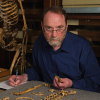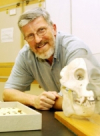Lucy 50th Anniversary Symposium: The Impact of "Lucy" on Human Origins Science
Event Hosted by:
Institute of Human Origins (IHO) at Arizona State University; Co-sponsored by CARTA
In-Person Location:
Arizona State University in Tempe, AZ at the Walton Center for Planetary Health Auditorium
Live Symposium Webcast:
Arizona State University Live
Talks were recorded by UCSD-TV and will be posted on this page in the coming weeks. Follow this page, as well as CARTA’s Facebook and Twitter accounts for updates. Visit the Institute of Human Origins (IHO) event page for additional event information.
Summary:
Lucy is one of the most famous fossils of all time. The discovery of this species had a major impact on the science of human origins and evolution. Why? What was that impact?
The symposium speakers—each a prominent scientist in their field—will address this question and specifically discuss the discovery’s impact through time, starting with the first few years after the discovery, the lasting impact, and the state of the art in that research area today.
We're celebrating the 50th anniversary of the discovery of the fossil skeleton “Lucy” with the aim of reigniting a global interest in how we “became human” and promoting the importance of connecting our human past to the global future on the planet.
| Speakers | Session |
|---|---|
 Donald Johanson |
Before Lucy: The state of knowledge on human origins Since my entry to the field of paleoanthropology in 1970, a more focused and rigorous implementation of an expanded collaborative, multinational, transdisciplinary strategy of inquiry with the application of new theoretical and technical innovations has resulted in a richer picture of our origins and a deeper understanding of how we became human—not only in Africa, but Eurasia as well. The discovery of Lucy 50 years ago provides an appropriate benchmark by which to contrast what we know in... read more |
 Ian Tattersall |
The discovery and initial interpretation of ‘Lucy’ as a tipping-point in paleoanthropology In retrospect, it is possible to see the middle-1970s discovery and initial analysis of the fossil NME AL 288-1, affectionately known as “Lucy,” as a major symbol, and even the driver, of a significant reorientation in the science of paleoanthropology. That change of perspective affected both the conceptualization and the practice of the science of human evolution. Before Lucy was discovered, the interpretation of the human fossil record had been dominated by practitioners of traditional expert... read more |
 Zeray Alemseged |
Lucy’s children and human origins Owing to its morphological and temporal placement, the Lucy species, Australopithecus afarensis, plays a pivotal role in our understanding of the human evolutionary career. Though many more fossil remains were recovered subsequent to Lucy’s discovery, the impact of the latter cannot be overstated not least its role as a trove of scientific data as well as its iconic nature. Research on Lucy and its species and continued fieldwork have inspired many research projects across Africa especially the... read more |
 Bernard Wood |
What was Lucy’s impact on our understanding of other australopith relatives? This talk begins by considering what the fossil and molecular evidence for early hominin evolution looked like in 1974, when conventional wisdom suggested that what were then called hominids and pongids had a relatively ancient divergence. It also predated the acquisition of the most compelling evidence that chimpanzees and bonobos were more closely-related to modern humans than to gorillas. The talk considers separately the impact of Lucy and the impact of Lucy’s ilk (i.e., the impressive... read more |
 Kaye Reed |
The Savanna “Hypothesis”: Tracing an enigmatic idea through time The savanna hypothesis is a long-lived idea concerning the role of the environment in the origin of hominin species—those that walk on two legs like humans and their ancestors. Scientists in the 19th century referred, vaguely, to apes and humans or human ancestors evolving away from each other and the latter moving to inhabit savannas—or more broadly, out of the forest and into the open. There were even suggestions that humankind emerged on savannas with no connection to forested apes.... read more |
 Carol Ward |
What was Lucy’s impact on our understanding of bipedality, diet, and encephalization? It is an exciting time in paleoanthropology. The pace of discovery of fossils seems to be increasing every year, leading to an expanding cast of characters on our branch of the primate family tree. New analytic approaches leading to insights into what these fossils tell us about our deep past, and what we know about the biology and behavior of our fossil relatives, is transforming our understanding of how we evolved. Yet despite these innovations, we still depend on Lucy. Her discovery 50 years... read more |
 Tracy Kivell |
Lucy and evolution of hand dexterity and tool use The discovery of the relatively complete skeleton of “Lucy” (A.L. 288-1) in 1974 in Ethiopia revealed unprecedented information about the early hominin body form and bipedal locomotion, but with only two hand bones (a capitate and proximal phalanx) preserved, Lucy offered limited insight into Australopithecus afarensis hand morphology. Fortunately, numerous A. afarensis hand bones were recovered from other sites within the Hadar Formation between 1974–1977, providing, at the time, the earliest... read more |
 Jessica Thompson |
How the paleo diet worked for Lucy—and led to us Evolution requires survival, and survival requires food. Information about what ancient creatures ate can unlock specific details about how and why they evolved, because not all foods are created equal. Some are dense in nutrients, but require knowledge, cooperation, or tools to access. Finding evidence for this in the fossil record can be challenging, because behavior doesn’t preserve. Other foods are easily available, but nutrient-poor. These often demand physical adaptations, such as large... read more |
 Anna K. Behrensmeyer |
How did Lucy become a fossil? Investigating the life, death, and preservation of a famous hominin Lucy’s discovery in 1974 transformed understanding the anatomy of Australopithecus afarensis and other early hominins. Geological research—stratigraphy and geochronology—answered the question, “When did Lucy live?” by placing her just above the Kada Hadar Tuff, dated at 3.21 Ma. As the initial excitement subsided, we began to ask new questions. How did hominins like Lucy live and interact with the African fauna and flora of 3 million years ago? Where did they live and how did they die? Geology... read more |
 Melissa Emery Thompson |
Lucy’s legacy and the past and future of primate research The histories of paleoanthropology and primatology have been deeply intertwined in the quest to understand human origins, dating from Darwin’s bold hypothesis that humans would likely have evolved in Africa from an ancestor that closely resembled the modern apes. However, for much of the 20th century, the relevance of nonhuman primates to anthropology was focused narrowly on what could be learned from anatomical comparisons. The discovery of the “Lucy” fossil, and the challenges it posed to... read more |
 Andra Meneganzin |
Naming Lucy: Taxonomic reasoning in paleoanthropology The 3.2-million-year-old female hominin skeleton retrieved in Ethiopia’s Afar region in November 1974 underwrites a paradigmatic history of naming. First known through the locality number assigned to the site of the discovery, AL-288-1, she soon became the human ancestor par excellence and an ambassador of human evolutionary studies with the nickname “Lucy” (also known as Dink’inesh in Amharic). The Linnean naming of the species, Australopithecus afarensis, formalized through the 1978... read more |
 Kim Hill |
Lucy’s contribution: Understanding the sequence of steps leading to human uniqueness Humans are a spectacular outlier among the millions of species of life on planet earth, with incredibly unique biological success. Slowly, scientists have begun to understand the traits that interacted to make us unique, such as cumulative culture, unique scales of cooperation, cognitive abilities, language, and a unique life history and mating system. However, the sequence of evolutionary events that led to our unique species was very much a mystery until the discovery of early bipedal... read more |
 Job Kibii |
Lucy, African heritage, and ‘Paleodoms’ Since the discovery of Lucy in 1974, African Heritage management and African paleoscientific research has undergone significant developments, reflecting changing priorities, challenges, and approaches to the promotion of research and preservation and conservation of archaeological and paleontological assets. African countries have engaged in partnerships with international organizations, governments, and NGOs to support heritage management efforts. Paleoscientific research in Africa has... read more |
 Ann Gibbons |
The first paleo-rock star: Is Lucy still an influencer? Ever since her discovery 50 years ago, Lucy has been a superstar. Her name, her age, her remarkably complete skeleton, and the story of her discovery captured the imagination of people all over the world. She has been a national treasure in Ethiopia and has been a popular ambassador for communicating about science and human evolution. Scientifically, she has been the benchmark for all other ancient hominins discovered since 1974. But much has changed in the 50 years since her discovery. There... read more |
 Yohannes Haile-Selassie |
Fifty years since Lucy’s discovery: Advances in scientific knowledge on human origins and the development of African paleosciences One of the most important and iconic fossil discoveries in the history of paleoanthropology is the 3.2-million-year-old partial skeleton nicknamed Lucy. Found in the Afar desert of Ethiopia in 1974, at a site called Hadar, Lucy’s discovery not only transformed the way paleoanthropologists thought about the earlier phases of human evolution, but also ignited significant interest in the survey and exploration of new fossiliferous areas in the Afar region of Ethiopia, the Turkana Basin in Kenya,... read more |
If you enjoy this event, please consider supporting CARTA's quest to explore and explain the human phenomenon.


